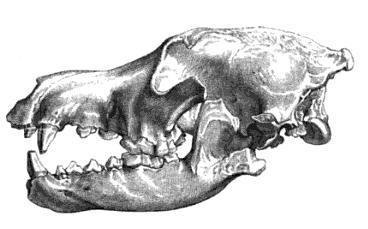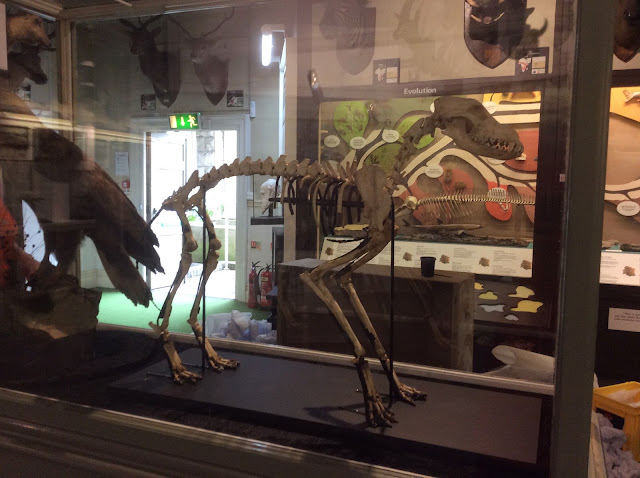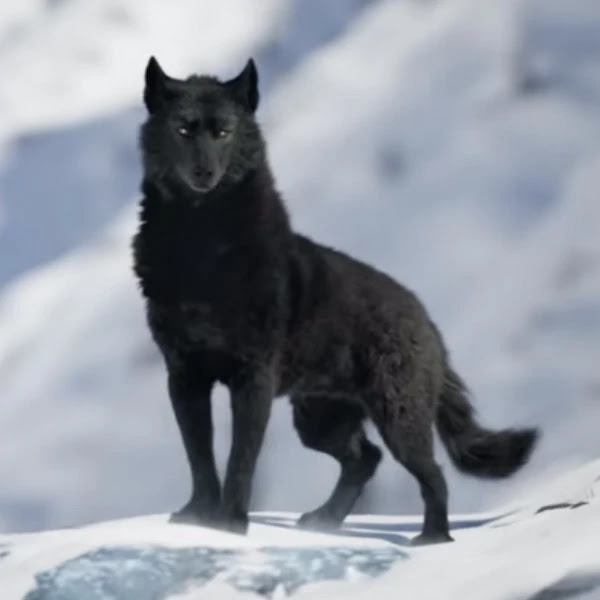A much more extensive look at British wolves will be included in The Red Paper 2022
The British Fox Study may have begun in 1976 with the intention of looking solely at British foxes, however, in 1977 my late friend Franklyn Angus Davin-Wilson asked a very simple question out of the blue about my thoughts on The Killer Canids of Cavan (then Ireland now Eire) ? My response was something like “The what?” This led to a very long investigation that only really ended in 2009 (though I am still looking at certain aspects). This led to wolves and much more.
In effect the Fox Study looks at any canid that existed or exists in the UK and my interest in canids (as with Felids) took in a lot –the Falkland Islands wolf was the original header image for the more wide reaching canid work.
We are raised and taught that the vermin red fox (Vulpes vulpes) we see today is what has
always been in the
We know from some DNA work done that the British Old Fox types were unique and not surprising since they were an isolated island species –as were those from Ireland/Eire.
One day it struck me that if the foxes were unique island species what about their bigger family members?
There is no doubt that, according to writing from Roman and later Saxon chronicles, that wolves appear to have been extraordinarily numerous in Britain and unlike some other British animals, wolves were unaffected by island dwarfism and some skeletal remains indicate that they may have grown as large as Arctic wolves. The species was, and this really should not come as a surprise as the story is the same from around the world, exterminated through a combination of deforestation and active hunting through bounty systems.
The question is often asked “When did wolves die out in the
According to Professor Stefan Buczacki in Fauna Britannica (Hamlyn, 2005 p. 528) it is recorded that in AD 950 King Athelstan imposed an annual tribute of 300 wolf skins on Welsh king Hywel Dda, while William of Malmesbury states that Athelstan requested gold and silver, and that it was his nephew Edgar the Peaceful who gave up that fine and instead demanded a tribute of wolf skins on King Constantine of Wales. In their book The Sports and Pastimes of the People of England from the Earliest Period Including the Rural and Domestic Recreations, May Games, Mummeries, Pageants, Processions and Pompous Spectacles (Methuen, 1801, pp. 12-13) , Joseph Strutt (corrections and additions made in 1903 by John Charles Cox) wolves at that time were especially numerous in the districts bordering Wales, which were heavily forested. This imposed “tax” was maintained until the Norman conquest of 1066.
It is very interesting to note that at the time there were several criminals who, rather than being put to death, were ordered to provide a certain number of wolf tongues annually. One assumes that this was a type of “community service order” –if you got the tongues you had rid the area of wolves but if the wolf got the person after its tongue –death sentence carried out. “Wolf roulette” of a kind.
A monk by the name of
Galfrid, writing about the miracles of St. Cuthbert some seven centuries
earlier, noted that wolves were so numerous in
We see in the way hunters operated the same mentality employed by later fox hunters and equally as successful (to the point of having to import foxes). The Anglo-Saxon Chronicle states that the month of January was known as “Wolf monath” as this was the first full month of wolf hunting by the nobility. This hunting season would officially end on the 25th March. This meant that it encompassed the “cubbing season” when wolves were at their most vulnerable and their fur was of greater quality (Richard Perry, Wildlife in Britain and Ireland 1978, London: Taylor and Francis).
During the reign of the Norman kings ( AD 1066-1154) servants were employed as wolf hunters and many of these held lands granted on the condition that they fulfilled this duty. William the Conqueror even granted the lordship of Riddesdale in Northumberland to Robert de Umfraville on the condition that he defend that land from enemies and wolves.
There were no actual restrictions as such on or penalties
for the hunting of wolves with one exception; hunting and killing them on Royal
game reserves. The reasoning behind this was that there might be the temptation
for a commoner to shoot a deer there would be too great (Emma Griffin, Blood
Sport: Hunting in
English wolves it seems were more often trapped than hunted but with the same end result. According to Strutt, the Wolfhunt family, residing in Peak forest in the 13th century, would go into the forest in March and December and place pitch in the areas wolves frequented. At that time of year wolves supposedly would have had far greater difficulty in smelling the pitch than at others. The idea being that the wolves paws would stick into the pitch and they could then be despatched. One might assume that wolves would not have had duller senses in winter but this apparently worked. During the dry summers the Wolfhunts would enter the forest to destroy cubs –as with foxes later, the “cubbing season”.
Gerald of Wales wrote that following Henry II’s punitive
expedition to
King John (1199-1216) even gave a premium of 10 shillings
for the capture of two wolves. King Edward I (1272-1307) gave the order for the
total extermination of all wolves in his kingdom and personally employed one
Peter Corbet and gave him an order to destroy wolves in the counties of
Gloucestershire, Herefordshire, Worcestershire,
In 1370 Edward III (1327 -1377) gave lands to one Thomas
Engaine who held lands in Pytchley in the county of Northampton, on the
condition that he find special hunting dogs to kill wolves in the counties of
Northampton, Rutland, Oxford, Essex and Buckingham. In 1433 during the reign of
Henry VI (1421 –1471), a Sir Robert Plumpton held a bovate of land called “Wolf
hunt land” in Nottingham, by service of winding a horn and chasing or
frightening the wolves in
In England the wolf is thought to have become ‘extinct’ or
at least very rare during the reign of Henry VII (1485–1509) wolves having
become limited to the Lancashire forests of Blackburnshire and Bowland, the
wilder parts of the Derbyshire Peak District, and the Yorkshire Wolds. Quite
obviously the claim of extinction was false and “extinct or very rare” an
obvious nonsense with wolves still in
A lot of the following information was on an old internet page which appears to have vanished now but I (luckily) saved it “in case”! I have no idea who the author is but if anyone knows please get in touch so that I can credit him/her.
Popular legend has it that the very last wolf killed in the
Scottish Highlands, which would have (if correct) have made it the last in
Britain, was killed by the hunter MacQueen, of Pall-a-chrocain, on the river
Findhorn, in 1743. MacQueen himself, who died in 1797, was said to be a giant
of a man and a renowned deer hunter. How much of the story is accurate depends
on your point of view but there are shades of the contemporaneous “Beast of
Gevaudan” (as dealt with in detail in my book Mysterious and Strange Beasts)
James Edmund Harting, from whose book British Animals Extinct Within Historic Times (1880) this account is drawn, quotes Sir Thomas Dick Lauder, from 1829, giving what he claimed were MacQueen's own words to MacIntosh (though setting the tale in Moy in Inverness-shire).
It is said that a “great black beast” had killed two children and the Laird of MacIntosh had called a meeting above Fi-Guithas to seek out and destroy the perpetrator. All were there at the allotted hour except for MacQueen who arrived late and MacIntosh asked sarcastically “What kept you?”
One assumes that MacQueen was rather smug when he responded "I brought him for you", and tossed down the severed head of the “last wolf” from under his plaid. He supposedly stated that:
“As I came through the slochk (i.e., ravine) I foregathered wi' the beast. My long dog there turned him. I buckled wi' him, and dirkit him, and syne whuttled his craig (i.e., cut his throat), and brought awa' his countenance for fear he might come alive again, for they are very precarious creatures.”
Harting alsorecounts the local legend of the last wolf in Strathglass, by Beauly, which was killed close to where St Ignatius' Well is today:
“... a woman of Cre-lebhan, near Strui, on the north side of Strath Glass... had gone to Strui a little before Christmas to borrow a girdle (a thick, circular plate of iron, with an iron loop handle at one side for lifting, and used for baking bread). Having procured it, and being on her way home, she sat down upon an old carn to rest and gossip with a neighbour, when suddenly a scraping of stones and rustling of dead leaves were heard, and the head of a Wolf protruded from a crevice at her side. Instead of fleeing in alarm, however, "she dealt him such a blow on the skull with the full swing of her iron discus, that it brained him on the stone which served for his emerging head."
The
And we politely leave the story there as we come to the Dionard wolf.
Graham Bruce, the Head Teacher of Durness Primary School in the far north of Sutherland, and a great enthusiast for old tales, gave me the newspaper clipping which I reproduce in full below. It's from The Northern Times From Our Old Files section, of September 2004. The publication date of the original piece was September 26th, 1929:
Standing midway between Brora and Helmsdale is a stone on which there is an inscription in effect that here, between 1690 and 1700, the last wolf in Sutherland was killed. From the following excerpt from an article to a Northern paper by a gentleman of veracity, it would appear that a wolf was seen in Sutherland as late as 1888.
The author of the article referred to who was the guest of a
shooting tenant in Sutherland, and was out alone on the hill one day when during
the afternoon a thick mist came down and this resulted in his losing his way.
As night was coming on, he decided to put up in a cave which he accidentally
came across in the
"I awoke with a great start and looked at my watch. It was one o'clock in the morning, and the weather had cleared. The moon appeared and the stars shone with a flickering and a frosty lustre like great diamonds on the black corsage of night. The musty odour had become most intense, and as my sleepy eyes threw off their shattered torpor, I saw with a shiver of apprehension a pair of sunken baleful looking eyes regarding me steadily and stealthily across the dying embers of the fire.
"I slipped a couple of cartridges into my gun, and as I did so I heard a low painful whine. I could now make out a white form like a huge dog lying not more than three feet from me. Its head rested on its paws and so far from showing any signs of hostility, it seemed to exhibit symptoms of friendliness. Its coat was a kind of silver-grey in colour and was thick and curly, but the face showed signs of great age.
"I stood up with my gun at my shoulder, but the beast did not move, and I could not find it in my heart to shoot; instead I threw it a ham sandwich. It nosed wearily, but did not attempt to eat it, so I tried it with a gorgonzola one, which it rejected with some evidence of repulsion. It then rose, and I saw to my unbounded astonishment that I was faced by a great silver-grey female wolf. She whined again, but kept her distance, and I then saw that in her eyes brooded a look of unutterable loneliness and misery.
"A female wolf, and the last wolf had been killed in Sutherland between 1690 and 1700. I could have gained lasting glory by shooting her, but my hand was stayed. It was I who had invaded her poor little dwelling, and she had shared it with me without hostility. She should suffer no harm from me. Her ancestors had wandered here when Scotland was joined to Greenland, and had shared these wan wastes with the majestic elk and the ivory-tusked boar; fighting and suffering and dying in those vast oak and pine forests, the remains of which are still visible in the great mosses which abound all over Sutherland."
Which may lead people to believe that is the end of the story. Wolves went extinct through massive persecution and destruction of habitat by humans. Not really. It is interesting that at the point in the mid 1700s when it was thought that the fox was about to become extinct like the wolf that travelling menageries and private zoos exhibited pairs of foxes…and wolves –because people wanted to see the “ferocious” canids that had once existed in Britain and also catch a glimpse of the fast disappearing fox.
In my work as an exotic species person (I never use the term “expert”) and running the Exotic Animals Register (EAR) since 1977 I have heard stories. I termed them stories as I really did not believe them at first –jackal accounts in the past (up to 1975) were well documented so I had no trouble believing those. The accounts I received were of wolves and there will be absolutely no clue as to the geographic areas for quite obvious reasons.
I was in weekly contact with a warden on a big estate and one day he told me in confidence about wolf reports from his area. At that point his credibility sunk like a lead weight in water. “What a pity there is no physical evidence of them” I replied to which he answered that there had been –at least two over a certain period had been killed on a very busy stretch of motorway but what was left by the time anyone go there was flattened and traffic far too busy to stop. These days even a smeared sample with DNA testing could identify the species. I was also told of a driver who almost crashed avoiding a wolf.
I put the phone down and added a big question mark next to
the warden’s name. A week later I was talking to the police wildlife crimes
officer in the area involved and at the end of the conversation I said: “Don’t
put the phone down when I say this because it’s what I was told!” and I then
explained about the RTA wolves and the near miss by the driver. The response
could have floored me back then: “Oh, right. Yes, two tentatively identified as
timber wolves and we know about a couple near misses”. Trying to keep calm and
remembering to never show much excitement and interest I mentioned a “local
estate warden” and the PWCO casually responded “Oh, ---- he’s a solid bloke. He
knows his wildlife and what is going on in the area.” I was then told “We are
not making this widely known, if you catch my drift?” I did. So the warden
reported the wolves and the police confirmed it. Still nothing solid I could
have examined but I did ask a respected wolf organisation in the
The whole situation seemed almost unreal to me yet I had what the warden said and police confirmed and later the farmer and his wife confirmed and the calls were obviously from wolves. Here, however, the wolves were not being shot or hunted but actually protected by the locals including farmers so I assume there must have been some compensation scheme for any sheep losses –unless it was put on the insurance claim as “dog attack”. (the full account is given in Red Paper 2022 Vol. 1 Canids
There is a second location but that is also not for publication and it appears wolf-dogs/coy-dogs have also been surviving in “the wilds”.
This brings me back to my original thought on species of wolf. It makes sense that if we had a distinct island species of fox then the equally isolated wolf species must also be unique? Could DNA be retrieved from wolfskins if they could be found? There was no taxidermy back in the period when wolves were hunted and killed in the hundreds each year but were skins preserved –or even heads?
In The Red Paper I looked at wolf hunts
in
So wild living wolves killed two people in 110 years and, again, we have no idea what the situation was that resulted in the deaths. Education is the vital thing if wolves were to be reintroduced and reintroduction should not carry the caveat "More than 20 we can start killing them to maintain low numbers".
Wolves and jackals have returned to Germany, the Netherlands, Luxembourg and other countries in Europe and so far only occasional livesstock attacks have been a problem.
It would be nice to see wolves back in Ireland or the UK but there is always an element of pro hunting and farmers objecting even if compensation is in place. It would be good to see a Ghost wolf -a melenistic (black) wolf- in the UK but I think the arguments will continue on for many years with no one really wanting to take the decision top reintroduce.



















No comments:
Post a Comment